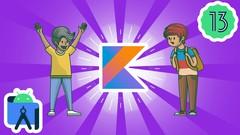Last Updated on March 4, 2023 by GeeksGod
Kotlin is the most popular programming language for building Android apps and it can also be can be used for any kind of development.
*Earn the Official Certificate after Completing the Course
Ocsaly Academy is proud to offer a comprehensive course on Android Development with Kotlin. With this course, you’ll learn how to use Kotlin, the modern programming language, to build beautiful, functional, and high-performing Android apps. Whether you’re a beginner or an experienced developer, you’ll find this course to be a valuable resource for learning Kotlin and Android development.
Here’s what you can expect to learn:
The basics of Kotlin programming languageBuilding and publishing your own Android appsEffective use of Android Studio and Android SDKBest practices for Android developmentNetworking and APIs integrationDatabase management and local storageMaterial design, animations, and advanced topicsan other high value topics on android.
The course is taught by experienced developers and certified Kotlin and Android experts. With their guidance and the support of a supportive community, you’ll have everything you need to master Kotlin and Android development. The course includes over 100 lectures and 13 hours of video content, and you’ll have lifetime access to all of the course materials.
Enroll in Ocsaly Academy’s Android Development with Kotlin course today and take the first step towards a successful career in Android development. With a 30-day money-back guarantee, you have nothing to lose and everything to gain. Start building amazing Android apps with Kotlin now!”
Are you trying to start a career in Android programming, but haven’t found the right way in? Do you have a great idea for an app, but don’t know how to make it a reality? Or maybe you’re just frustrated that to learn Android, you must already know Kotlin. If so, then this course is for you
Quickly putting together a prototype of an idea, refining it, and then deciding to run with it and wire it up into a fully-fledged app, is such an exciting and rewarding process. Any programming can be fun – I have been programming all my life – but creating for Android is somehow extraordinarily rewarding..
Kotlin is the most succinct language, and therefore is the least error-prone, which is great for beginners. Kotlin is also the most fun language, mainly because the succinctness means you can get results faster and with less code. Google considers Kotlin an official (first-class) Android language. There are some other advantages to Kotlin that make it less error-prone and less likely to make mistakes that cause crashes. We will discover the details of these advantages as we proceed.
Kotlin is an object-oriented language. This means that it uses the concept of reusable programming objects. If this sounds like technical jargon, another analogy will help. Kotlin enables us and others (like the Android API development team) to write code that can be structured based on real-world things, and here is the important part – it can be reused.
Kotlin remains one of the most widely used and fastest-growing programming languages in recent years. Developers across the globe prefer using Kotlin for a range of projects such as data science, server-side or cloud development, etc. The demand for Kotlin is on the rise and it will continue to grow in the years to come. In this post, let’s explore the top five reasons why Kotlin is a great programming language to learn in 2023.
1. Modern language
It is a modern programming language that brings together the best of object-oriented and functional programming. Some of the most promising features of Kotlin include clean compact syntax, secure, general-purpose, and more.
2. Great materials
There are ample materials available on Kotlin that learners can leverage to have a good grasp of the programming language. There are numerous courses that a beginner can start with. Most of these courses are self-paced and offer great insights into the programming language. Also, the developer community is quite huge so if learners get stuck or have queries they can always seek solutions from the developer community.
3. Easy to learn
Kotlin’s syntax is easy to learn for beginners and it offers a host of powerful features. It can be a great language to upskill for experienced programmers. It has a shallow learning curve especially if you have experience in Python or Java. The programming language is also quite easy for iOS developers as it is based on familiar concepts of modern technology.
4. Career prospects
Many leading brands use Kotlin for their software and Kotlin skills are highly in demand. If estimates are to be believed, job postings related to Kotlin skills are skyrocketing since 2023 by 1400%.
5. Community support














